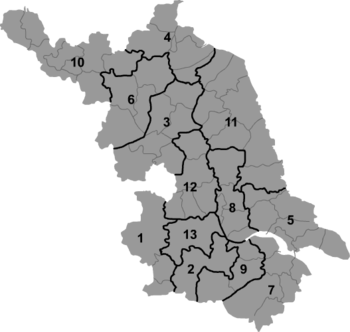Baoying County
| Baoying County 宝应县 | |
|---|---|
| County | |
 Baoying Location in Jiangsu | |
| Coordinates: 33°12′58″N 119°25′44″E / 33.216°N 119.429°ECoordinates: 33°12′58″N 119°25′44″E / 33.216°N 119.429°E[1] | |
| Country | People's Republic of China |
| Province | Jiangsu |
| Prefecture-level city | Yangzhou |
| Time zone | UTC+8 (China Standard) |
| Website |
baoying |

Baoying County (simplified Chinese: 宝应县; traditional Chinese: 寶應縣; pinyin: Bǎoyīng Xiàn) is under the administration of Yangzhou, Jiangsu province, China. It has a population of 919,900 (2004) and a land area of 1,483 square kilometres (573 sq mi). The northernmost county-level division of Yangzhou City, it borders the prefecture-level cities of Yancheng to the east and Huai'an to the north and west.
Administrative sub-districts
Baoying administers a total of fourteen towns.
History
Etymology
Baoying was known as Anyi of Chu zhou (Chu prefecture, 楚州), where supposedly the divine treasures were found in 762. As auspicious tributes, they were presented to the Emperor Suzong of Tang, and found favour with him. It was a coincidence that the then heir apparent, later Emperor Daizong, was the Prince of Chu. The supposed treasures showed the Heaven was sympathetic to the emperor in the future. Thus, the reign title was changed into Baoying (rough meaning: "the treasures show the sympathy [from the Heaven]"), and the county was also bestowed such a name.[2]
References
- (in Chinese) "Illustrated Album of Yangzhou Prefecture", from 1573–1620, has illustrations of Baoying
- ↑ Google (2014-07-02). "Baoying" (Map). Google Maps. Google. Retrieved 2014-07-02.
- ↑ Old Book of Tang. 40. "肅宗上元三年建巳月,於此縣得定國寶十三枚,因改元寶應,仍改安宜為寶應"; 太平廣記 [Extensive Records of the Taiping Reign]. 404. "時肅宗寢疾方甚,視寶,促召代宗謂曰:「汝自楚王為皇太子,今上天賜寶,獲於楚州。天許汝也,宜保愛之。」"